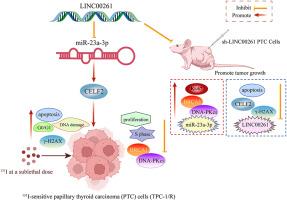LINC00261 triggers DNA damage via the miR-23a-3p/CELF2 axis to mitigate the malignant characteristics of 131I-resistant papillary thyroid carcinoma cells
IF 2.3
Q3 BIOCHEMISTRY & MOLECULAR BIOLOGY
引用次数: 0
Abstract
Background
Long-chain non-coding RNA (LINC00261) in the treatment of papillary thyroid carcinoma (PTC) with 131I is still unknown despite its proven anti-tumour effect in thyroid cancer (TC) and other types of cancer.
Methods
The database and RT-qPCR were used to analyze the expression level of LINC00261 in PTC and cell lines. PTC cells resistant to 131I (TPC-1/R) were created through ongoing exposure to a lethal dose of 131I, and a subcutaneous xenotransplantation model was developed using PTC mice. Bioinformatics analysis and dual-luciferase assays demonstrated the interaction between LINC00261, miR-23a-3p, and CELF2. RT-qPCR and Western blot were used to detect the expression of LINC00261, miR-23a-3p, and CELF2. Additionally, CCK-8, flow cytometry, immunofluorescence (IF), Western blot, and comet assay were employed to measure cell viability level and DNA damage.
Results
PTC cell lines exhibited a decrease in the expression of LINC00261. The growth and progression through the S-phase of TPC-1/R cells were suppressed by LINC00261, leading to increased apoptosis and DNA damage. The objective of LINC00261 was to regulate the axis of miR-23a-3p/CELF2. Downregulating LINC00261 enhances the growth and advancement of 131I-resistant cells in the S-phase by activating the miR-23a-3p/CELF2 pathway while suppressing cell death and DNA harm. The miR-23a-3p/CELF2 axis activates DNA damage in 131I-resistant PTC cells by LINC00261.
Conclusions
LINC00261 activates DNA damage in 131I-resistant PTC cells caused by miR-23a-3p/CELF2 axis, improving the progression of cancer cells of PTC.

LINC00261通过miR-23a-3p/CELF2轴引发DNA损伤,从而减轻耐131I甲状腺乳头状癌细胞的恶性特征
背景长链非编码RNA(LINC00261)在甲状腺乳头状癌(PTC)131I治疗中的作用尚不清楚,尽管它在甲状腺癌(TC)和其他类型癌症中的抗肿瘤作用已得到证实。方法利用数据库和RT-qPCR分析LINC00261在PTC和细胞系中的表达水平。通过持续暴露于致死剂量的 131I 建立了对 131I 耐药的 PTC 细胞(TPC-1/R),并利用 PTC 小鼠建立了皮下异种移植模型。生物信息学分析和双荧光素酶测定证明了LINC00261、miR-23a-3p和CELF2之间的相互作用。RT-qPCR 和 Western 印迹被用来检测 LINC00261、miR-23a-3p 和 CELF2 的表达。此外,还采用了 CCK-8、流式细胞术、免疫荧光(IF)、Western 印迹和彗星试验来检测细胞活力水平和 DNA 损伤。LINC00261抑制了TPC-1/R细胞的生长和S期进展,导致细胞凋亡和DNA损伤增加。LINC00261 的目的是调节 miR-23a-3p/CELF2 轴。通过激活 miR-23a-3p/CELF2 通路,下调 LINC00261 可增强 131I 抗性细胞在 S 期的生长和进展,同时抑制细胞死亡和 DNA 损伤。结论LINC00261能激活miR-23a-3p/CELF2轴引起的131I耐药PTC细胞的DNA损伤,改善PTC癌细胞的进展。
本文章由计算机程序翻译,如有差异,请以英文原文为准。
求助全文
约1分钟内获得全文
求助全文
来源期刊

Biochemistry and Biophysics Reports
Biochemistry, Genetics and Molecular Biology-Biophysics
CiteScore
4.60
自引率
0.00%
发文量
191
审稿时长
59 days
期刊介绍:
Open access, online only, peer-reviewed international journal in the Life Sciences, established in 2014 Biochemistry and Biophysics Reports (BB Reports) publishes original research in all aspects of Biochemistry, Biophysics and related areas like Molecular and Cell Biology. BB Reports welcomes solid though more preliminary, descriptive and small scale results if they have the potential to stimulate and/or contribute to future research, leading to new insights or hypothesis. Primary criteria for acceptance is that the work is original, scientifically and technically sound and provides valuable knowledge to life sciences research. We strongly believe all results deserve to be published and documented for the advancement of science. BB Reports specifically appreciates receiving reports on: Negative results, Replication studies, Reanalysis of previous datasets.
 求助内容:
求助内容: 应助结果提醒方式:
应助结果提醒方式:


